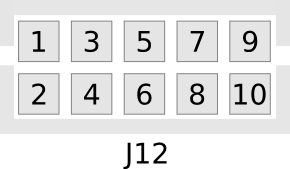The E3x0/X3x0 are the first USRP devices to offer an auxiliary GPIO connection on the motherboard itself (independent of the daughterboards). These GPIO pins are controlled directly by the FPGA, where they are controlled by an ATR (Automatic Transmit / Receive). This allows them to be toggled simultaneously with other radio-level changes (e.g., enabling or disabling a TX or RX mixer).
The GPIO port is not meant to drive big loads. You should not try to source more than 5mA per pin.
The +3.3V is for ESD clamping purposes only and not designed to deliver high currents.


ATR works by defining the value of the GPIO pins for certain states of the radio. This is the "automatic" part of it. For example, you can tell UHD that when the radio is transmitting and receiving (full duplex), GPIO6 should be high, but when it is only transmitting, GPI06 should be low. This state machine is set up using a series of GPIO attributes, with paired values and a mask, which you will want to define for the GPIO pins you intend to use. To set up the ATR, you use uhd::usrp::multi_usrp::set_gpio_attr().
The counterpart to setting the ATR (the "getter"), is called uhd::usrp::multi_usrp::get_gpio_attr(). t has the exact same attributes as above, and has one more:
The front panel X3x0 GPIO bank is enumerated in the motherboard property tree (<mb_path>/gpio/FP0/\*), the E3x0 internal GPIO bank as (<mb_path>/gpio/INT0/\) and so are easily accessible through the standard uhd::usrp::multi_usrp UHD interface.
You can discover this using the uhd::usrp::multi_usrp::get_gpio_banks() function. This will tell you that there is a GPIO bank on your X3x0 called "FP0" (for E3x0 this will be called "INT0"). This is the bank we want to set-up.
Let's say we want to use GPIO6 for an external amp. We want it to be automatically controlled by ATR as an output, and we want it to be high when we are transmitting, and low in all other cases. We are also using GPIO4, which we want to control manually, as an output. We can set this up with the following code:
After the above code is run, the ATR in the FPGA will automatically control GPIO6, as we have described, based on the radio state, and we have direct manual control over GPIO4.
The following example has been modified to work with he E3x0's internal GPIO bank, where the controlled GPIO is now GPIO3 instead of GPIO6.
After the above code is run, the ATR in the FPGA will automatically control GPIO3, as we have described, based on the radio state, and we have direct manual control over GPIO4.